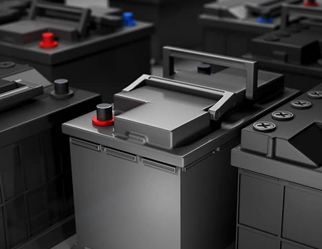Common battery technologies
Over the years, the most common battery technologies have improved significantly, offering increased energy density, faster charging capabilities, larger battery capacities and more cost-effective solutions.
Lead-acid batteries
Lead-acid batteries, also known as flooded batteries, are a reliable and cost-effective source of power. According to the Battery Council International (BCI), lead-acid batteries provide 50% of the world's rechargeable power. These batteries are used in a wide range of industries and applications, including Uninterruptible Power Supplies (UPS), data centers, medical facilities, security and public safety sectors, communication networks and much more. Compared to other batteries, lead-acid batteries typically have lower energy densities, shorter lifespans, safety risks and more maintenance requirements. However, with enhanced electrode designs and electrolyte formulations, these batteries now have improved energy density, charging capabilities and durability.
Sealed Lead Acid (SLA) batteries
SLA batteries are rechargeable, spill-proof batteries based off a lead-acid design. These batteries are also maintenance-free and safer, unlike flooded batteries. With benefits such as high durability and the ability to deliver high surge currents, they are used in fire and alarm systems, UPS systems, emergency lighting, a variety of commercial equipment and other critical applications requiring backup power or off-grid use. In recent years, Absorbent Glass Mat (AGM) batteries, a type of SLA battery, have gained significant interest. Compared to traditional SLA batteries, AGM batteries offer a higher voltage output and a longer lifespan, even when deep-cycled. They also provide excellent electrical reliability and better recharging efficiency.
Lithium and Lithium-ion (Li-ion) batteries
Using a liquid electrolyte solution, lithium batteries are one of the most high-performing batteries for electronics. Although they come at a higher price point, these batteries are non-rechargeable but designed to last longer, lasting up to six times more (depending on the manufacturer) than alkaline batteries. Lithium batteries are used for various electronics, including cameras, smoke detectors, powerful tools and other appliances.
Lithium-ion (Li-ion) batteries are a much-improved version of standard lithium batteries, making them the go-to choice in the industry currently. Because they are rechargeable, Li-ion batteries are more cost-effective in the long run and help reduce waste. One of the most significant improvements in Li-ion battery technology is the increase in energy density, allowing for even longer-lasting battery life. And while Li-ion batteries typically cost more than other batteries, their price has been reduced by 90% over the past decade. Apart from offering reliable power for electronics, Li-ion batteries can also be used for more complex systems, including emergency power backup systems and surveillance or alarm systems.
